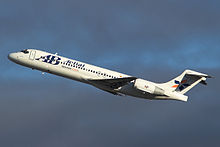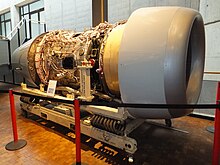Rolls-Royce BR700
The name BR700 is a series of turbofan engines built by Rolls-Royce Germany . The BR engines are twin-shaft engines in the medium thrust class and are intended for business travel and smaller airliners. They are particularly characterized by their low noise and pollutant emissions and low consumption.
history

The companies BMW and Rolls-Royce founded a joint venture in 1991, BMW Rolls-Royce AeroEngines GmbH , based in Oberursel (Taunus) and later Dahlewitz in Brandenburg . The company's aim was to develop small and medium-sized engines for the business and regional jet segment. In the same year, development work on the engine core began in Lohhof under the leadership of Günter Kappler . The first run of the core engine in Great Britain took place in 1993, followed by the first run of the first type BR710 in Dahlewitz a year later. The BR700 family has been the only aircraft jet engine program that has been completely developed and built in Germany since the Second World War.
In 1999, "BMW Rolls-Royce" was restructured and since then has been trading as "Rolls-Royce Germany" and is the only officially approved engine manufacturer in Germany with development, manufacturing and maintenance approval for modern civil and military turbine engines. The 1000th engine was delivered in 2003. The engines of the BR700 series are manufactured by Rolls-Royce Germany in the Oberursel and Dahlewitz plants. Components and parts are manufactured in the factory halls of the former Klöckner-Humboldt-Deutz Luftfahrttechnik in Oberursel, while development, final assembly and test runs of the finished engines are carried out in a factory in Dahlewitz built in the early 1990s. In addition, other components come from Great Britain and France as well as from other aviation suppliers.
BR710
The BR710 version is intended for long- range business jets and is used in the Gulfstream V , Bombardier Global family (Global Express XRS, 6000 and 5000) and Gulfstream G550, as well as in the British Aerospace Nimrod MRA4, which was decommissioned in 2011 . As a special technical feature, the bypass duct is made from CFRP . The engine was approved in 1996, and the 2,000th unit was manufactured in early 2011.
BR715
The BR715 is designed for around 100-seat aircraft and is used in the Boeing 717-200 and some versions of the Tupolev Tu-334 . With the end of production of the Boeing 717 in May 2006, only a few BR715 engines were manufactured. There are the versions BR700-715C1-30, BR700-715B1-30 and BR700-715A1-30 with 95.33 kN, 89.68 kN and 83.23 kN thrust. The two-stage low pressure compressor and the bypass duct are made of titanium.
BR725
The BR700 series is being expanded with the BR725. The engine completed its successful first run on the test bench on April 28, 2008 and received its type certification from the EASA in July 2009 and from the FAA in early 2010. By adopting improvements from the Trent engine series for the fan, it should achieve 5% more thrust, consume 4% less fuel, emit fewer pollutants (21% less nitrogen oxides, 72% less smoke gases) and be 4 dB quieter than a BR710. In addition, the maintenance interval has been extended from 3000 to 10,000 hours. To achieve this, a fan with 24 curved titanium blades of great depth is used; the fan outlet guide vanes are made of composite material. In addition, the second to sixth stages of the high-pressure compressor are designed in a blisk design. The digital engine control was taken over from the Trent 1000.
The BR725 is the exclusive engine for the Gulfstream G650 business jet .
Technical specifications
| BR700 family data | |||
|---|---|---|---|
| BR710 | BR715 | BR725 | |
| Thrust (kN) | 65.6-68.4 | 83.23-95.33 | 75.2 |
| Bypass ratio | 4: 1 | 4.55: 1-4.68: 1 | 4.2: 1 |
| Dry weight (kg) (depending on the version) | 1820-1890 | 2085 | 1635 |
| Length (m) | 4.7 | 3.7 | 3.3 a |
| Fan diameter (m) | 1.22 | 1.47 | 1.27 |
| High pressure compressor stages | 10 | 10 | 10 |
| High pressure turbine stages | 2 | 2 | 2 |
| Fan levels | 1 | 1 | 1 |
| Low pressure turbine stages | 2 | 3 | 3 |
| Combustion system | ring-shaped with 20 burners | ||
| Certification (depending on the version) | 1996-2002 | 1998 | 2009 |
a The length of the engine is given without thrust reversal .
Individual evidence
- ↑ Back to the roots . In: Der Spiegel . No. 19 , 1990, pp. 136-137 ( Online - May 7, 1990 ).
- ↑ Much too small for two . In: Der Spiegel . No. 32 , 1991, pp. 102-103 ( Online - Aug. 5, 1991 ).
- ↑ a b History of Rolls-Royce Germany, accessed on April 11, 2009
- ^ Nimrod R1 aircraft in final flight for RAF. In: BBC. July 28, 2011, accessed May 19, 2019 .
- ↑ BR710. In: Rolls-Royce plc. Retrieved May 18, 2019 .
- ↑ Patrick Hoeveler: Rolls-Royce celebrates 20 years in Dahlewitz. In: Flugrevue. October 1, 2013, accessed May 19, 2019 .
- ↑ FlugRevue June 2008 ILA Extra, pp. 10–11, Strong Trio, first run of the BR725 in Dahlewitz
- ↑ BR725. In: Rolls-Royce plc. Retrieved May 18, 2019 .
- ↑ a b Type approval of the BR700-710 - EASA-TCDS-E.018 ( page no longer available , search in web archives ) Info: The link was automatically marked as defective. Please check the link according to the instructions and then remove this notice. (PDF, 124 kB)
- ↑ Type approval of the BR700-715 - EASA-TCDS-E.023 (PDF, 104 kB)

